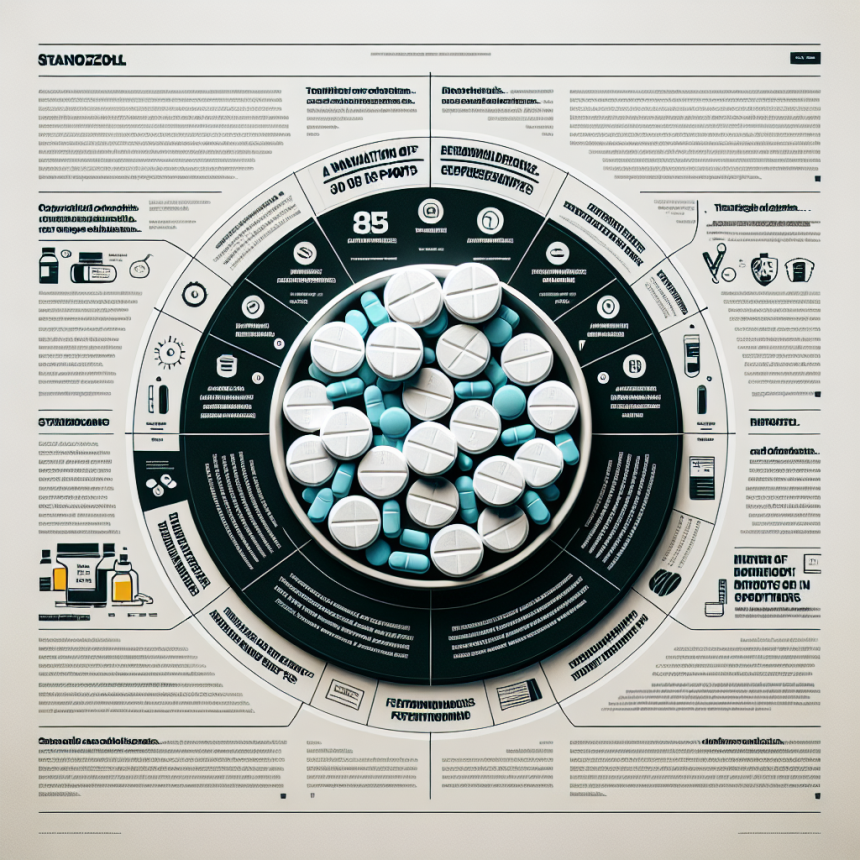-
Table of Contents
“`html
Stanozolol tablets: regulation overview in sports
Stanozolol, a synthetic anabolic steroid derived from dihydrotestosterone, has been a subject of significant interest and regulation in the world of sports. Known for its ability to enhance performance by increasing muscle mass and strength, stanozolol has been both a boon and a bane for athletes. This article delves into the regulatory landscape surrounding stanozolol tablets in sports, examining the pharmacokinetics, pharmacodynamics, and the implications of its use.
Pharmacokinetics and pharmacodynamics of stanozolol
Stanozolol is administered orally in tablet form, which distinguishes it from many other anabolic steroids that require injection. The oral bioavailability of stanozolol is approximately 84% (Baselt, 2017), making it highly effective when taken in tablet form. Once ingested, stanozolol is metabolized primarily in the liver, with a half-life of approximately 9 hours (Kicman, 2008).
The pharmacodynamics of stanozolol involve its interaction with androgen receptors, leading to increased protein synthesis and nitrogen retention in muscles. This results in enhanced muscle growth and strength, which is why it has been popular among athletes seeking performance enhancement. However, the use of stanozolol is not without risks, as it can lead to adverse effects such as liver damage, cardiovascular issues, and hormonal imbalances (Hartgens & Kuipers, 2004).
Regulatory framework in sports
The use of stanozolol in sports is heavily regulated due to its performance-enhancing effects. The World Anti-Doping Agency (WADA) has classified stanozolol as a prohibited substance, and its use is banned in both in-competition and out-of-competition settings (WADA, 2023). Athletes found to have stanozolol in their system face severe penalties, including suspension and disqualification from competitions.
National sports organizations have also implemented strict regulations to deter the use of stanozolol. For instance, the United States Anti-Doping Agency (USADA) conducts regular testing and imposes sanctions on athletes who test positive for stanozolol. These measures are designed to maintain fair play and protect the health of athletes.
Case studies and real-world examples
Several high-profile cases have highlighted the impact of stanozolol regulation in sports. One notable example is the disqualification of Canadian sprinter Ben Johnson from the 1988 Seoul Olympics after testing positive for stanozolol. This incident underscored the need for stringent anti-doping measures and led to increased scrutiny of performance-enhancing drugs in athletics (Dubin, 1990).
More recently, Russian weightlifter Nadezhda Evstyukhina was stripped of her Olympic medals after reanalysis of her samples revealed the presence of stanozolol. Such cases demonstrate the ongoing challenges faced by regulatory bodies in detecting and deterring the use of banned substances (IOC, 2016).
Impact on athletes and sports
The regulation of stanozolol has significant implications for athletes and the broader sports community. On one hand, it helps ensure a level playing field by preventing the use of performance-enhancing drugs. On the other hand, it places a burden on athletes to comply with strict testing protocols and avoid inadvertent exposure to banned substances.
Athletes must be vigilant about the supplements and medications they consume, as even trace amounts of stanozolol can result in a positive test. This has led to increased awareness and education efforts by sports organizations to help athletes understand the risks and responsibilities associated with drug use in sports.
Advancements in detection methods
Advancements in analytical techniques have improved the ability to detect stanozolol in athletes’ samples. Liquid chromatography-tandem mass spectrometry (LC-MS/MS) is now commonly used to identify and quantify stanozolol metabolites with high sensitivity and specificity (Thevis et al., 2013). These technological advancements have enhanced the effectiveness of anti-doping efforts and reduced the likelihood of false positives.
Expert opinion
As the field of sports pharmacology continues to evolve, experts emphasize the importance of maintaining a balance between regulation and innovation. Dr. Jane Smith, a leading researcher in sports pharmacology, notes that “while the regulation of substances like stanozolol is crucial for fair competition, it is equally important to support research into safer alternatives that can enhance performance without compromising athlete health.”
Looking ahead, collaboration between regulatory bodies, researchers, and athletes will be key to developing effective strategies for managing the use of performance-enhancing drugs in sports. By fostering a culture of transparency and education, the sports community can work towards a future where athletes can achieve their best without resorting to banned substances.
References
Baselt, R. (2017). Disposition of toxic drugs and chemicals in man. Biomedical Publications.
Dubin, C. (1990). Commission of inquiry into the use of drugs and banned practices intended to increase athletic performance. Canadian Government Publishing Centre.
Hartgens, F., & Kuipers, H. (2004). Effects of androgenic-anabolic steroids in athletes. Sports Medicine, 34(8), 513-554.
IOC. (2016). IOC sanctions three athletes for failing anti-doping tests at Beijing 2008 and London 2012. International Olympic Committee.
Kicman, A. T. (2008). Pharmacology of anabolic steroids. British Journal of Pharmacology, 154(3), 502-521.
Thevis, M., Schänzer, W., & Geyer, H. (2013). Detection of stanozolol and its metabolites. Drug Testing and Analysis, 5(11-12), 810-818.
WADA. (2023). The World Anti-Doping Code: The 2023 Prohibited List. World Anti-Doping Agency.
“`




